Feb 21, 2013 | illustration, interviews
Contemporary artist Shari Rubeck uses watercolor and acrylics to create simple scenes filled with glamour, curiosity and chaos. Each brightly colored artwork beautifully explores the human psyche, with a suggested meaning that’s left open to interpretation . Her style is multi-faceted, each series develops its own sort of visual voice that usually involves some kind of animal imagery along with a sense of raw purity, the paint allowed to run and swirl organically in confined areas of the composition.
“Lion Girl” is a watercolor and graphite work that shows a woman standing defiantly, hands on her hips as her serene face is overlaid with that of a powerful lion roaring, the color of his mane melting into her fiery tethered dress. A girl in a blue dress leans impossibly far to the right in “Sharp Intrusion,” her head hidden by a glowing red space helmet with five birds flying towards it, as if they were working as a team to knock her over.
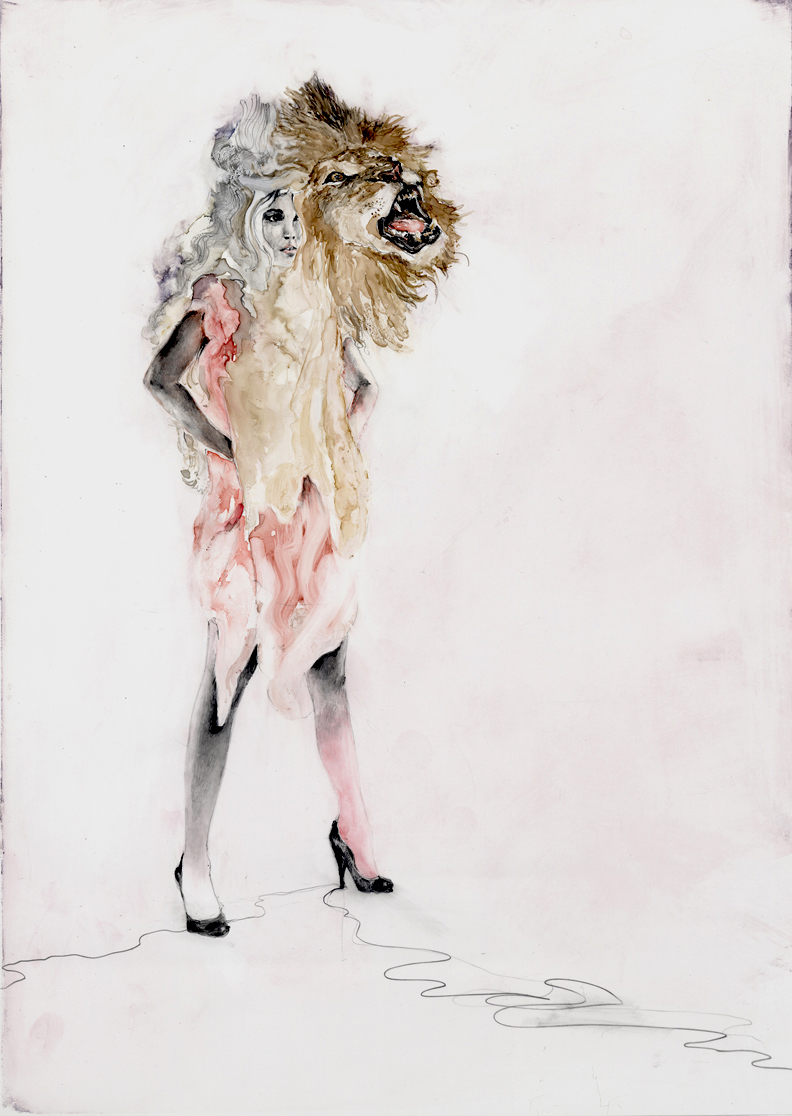
What’s the first thing you can remember painting?
The inside of my parent’s station wagon with crayons is one of my earliest artistic memories. But my first memory of painting would have to be when I received a good quality set of brushes and went to town filling large pieces of watercolor paper with all varieties of brushstrokes until I could think of no more.
What do you think watercolor adds to the creation of a piece?
Watercolors are fresh, light and have an immediate quality. I am working to bring that sense of luminescence to some of my larger acrylic paintings on linen.
What do you like about including animals in your work? Particularly bunnies?
Animals are a big part of my life and psyche. They are present often in my thoughts, dreams and work. They are my connection to the subtle workings of the world. They are magical, intuitive, and fierce, connected and make wonderful story tellers. As a human race we have turned our backs on them. Should technology suddenly drop off we would look to them for knowledge, guidance and find ourselves thanking them once again for sustenance.
The Bunnies arrived on the ‘scene’ soon after I began ‘working’ a puppet, named ‘Bunny’ for my son in his struggle to find comfort of sleep at bedtime. Bunny has a tremendously silly, but slightly cynical sense of humor and became my artistic story teller. The bunnies illustrate humor in the serious and not so serious sides of life’s events and emotions.
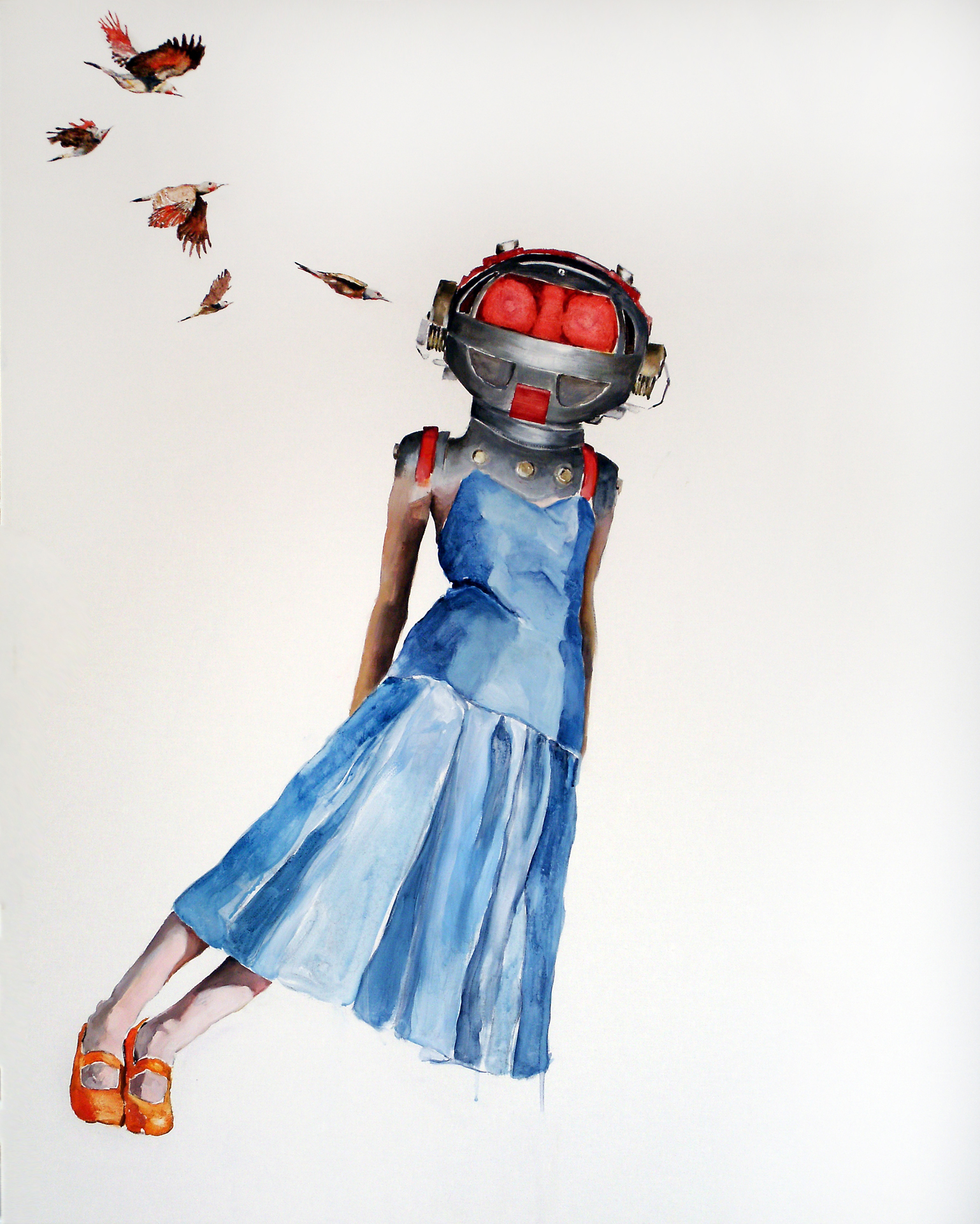
Who are the people your works represent?
The figures in my work represent all of us – humans and humanness. Some pieces are more representative of my own self and direct experiences, while others are observations from distant perspectives.
What do empty backgrounds allow for in your work and how do you choose a background for each character?
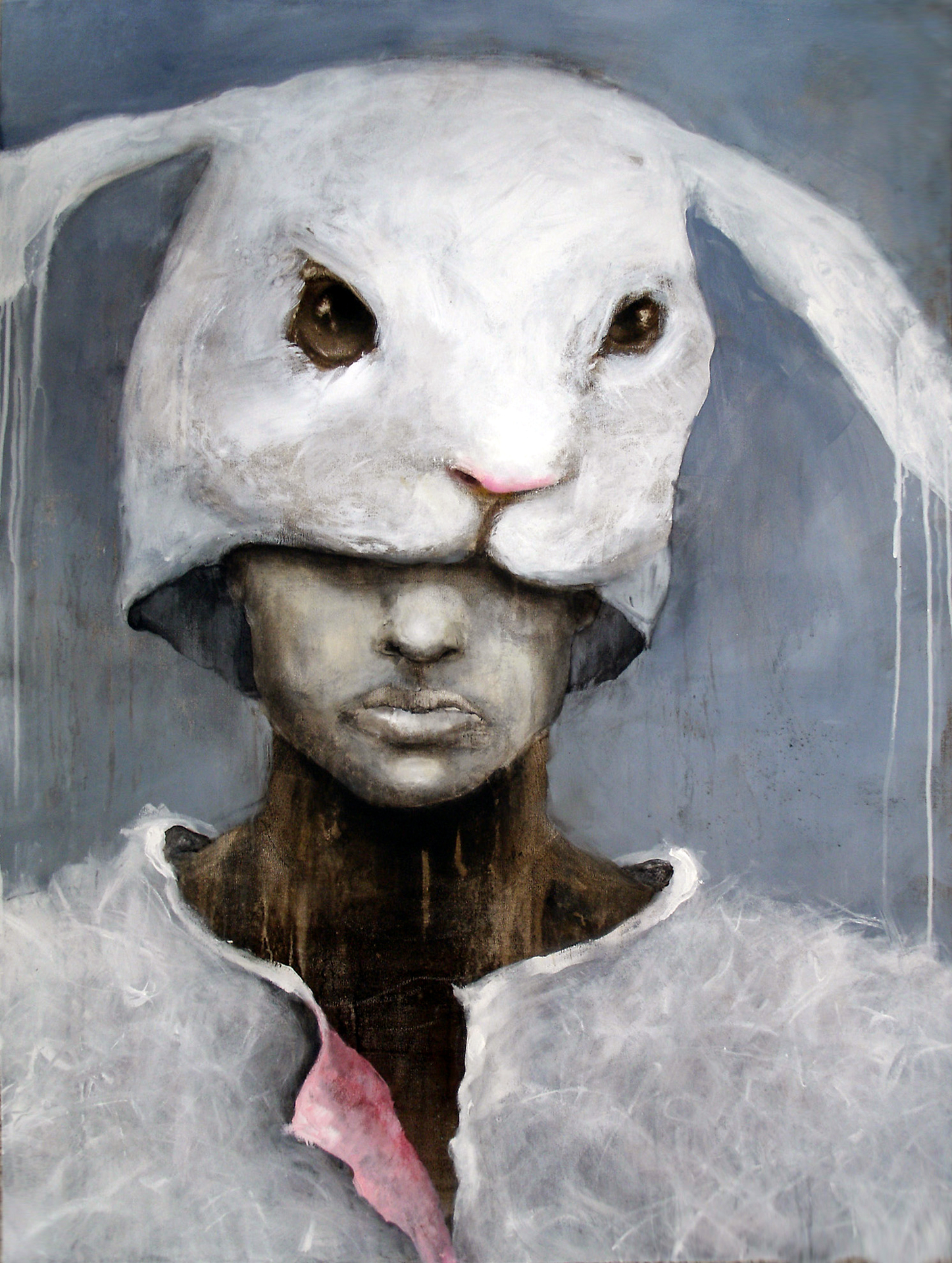 I fluctuate between giving color & detail to the areas surrounding my characters and leaving them alone in their space. An intense drive to express an idea, message or observation leaves me feeling that the figures can communicate strongly without anything around them. The blank or negative space is carefully considered and tells much about the tensions while simultaneously allowing for areas of visual repose.
I fluctuate between giving color & detail to the areas surrounding my characters and leaving them alone in their space. An intense drive to express an idea, message or observation leaves me feeling that the figures can communicate strongly without anything around them. The blank or negative space is carefully considered and tells much about the tensions while simultaneously allowing for areas of visual repose.
What do you like about the image of a figure with a mismatched head?
A figure with mismatched head…isn’t that what we all are? Or I could elaborate and say that we are all different degrees of mask wearers. My Ego series transformed into the Alter Egos. The first Alter Ego shows a human wearing a bunni mask or a bunni wearing a human – there is some ambiguity. I have always been intrigued by masks and what they can represent. There is so much that goes on ‘backstage’. I do also love the weight of a head that is too large for its body; whether mechanical or creature.
What are some of the art websites or blogs you follow?
Some sites that I am affiliated with or keep up with are: BlueCanvas, Twitter, ARTCZAR, Elisa Contemporary, Artsrogueisland, GalleryZ, ColoColo, Hallway Gallery, and now of course ThingsWorthDescribing. I find many intriguing sites on random searches but may only visit them once.
Minor Situations is her newest series of bunny paintings that’s by far the most adorable – fluffy floppy characters shown after a small disappointment like burning toast, letting balloons go, or spilling milk. Their little bunny faces look so downtrodden, and their long ears allow for an exaggerated sense of unhappiness as they fall down the back of every bunny. Simple scenes against bright-colored backgrounds, these works are lovable in a silly sad way.


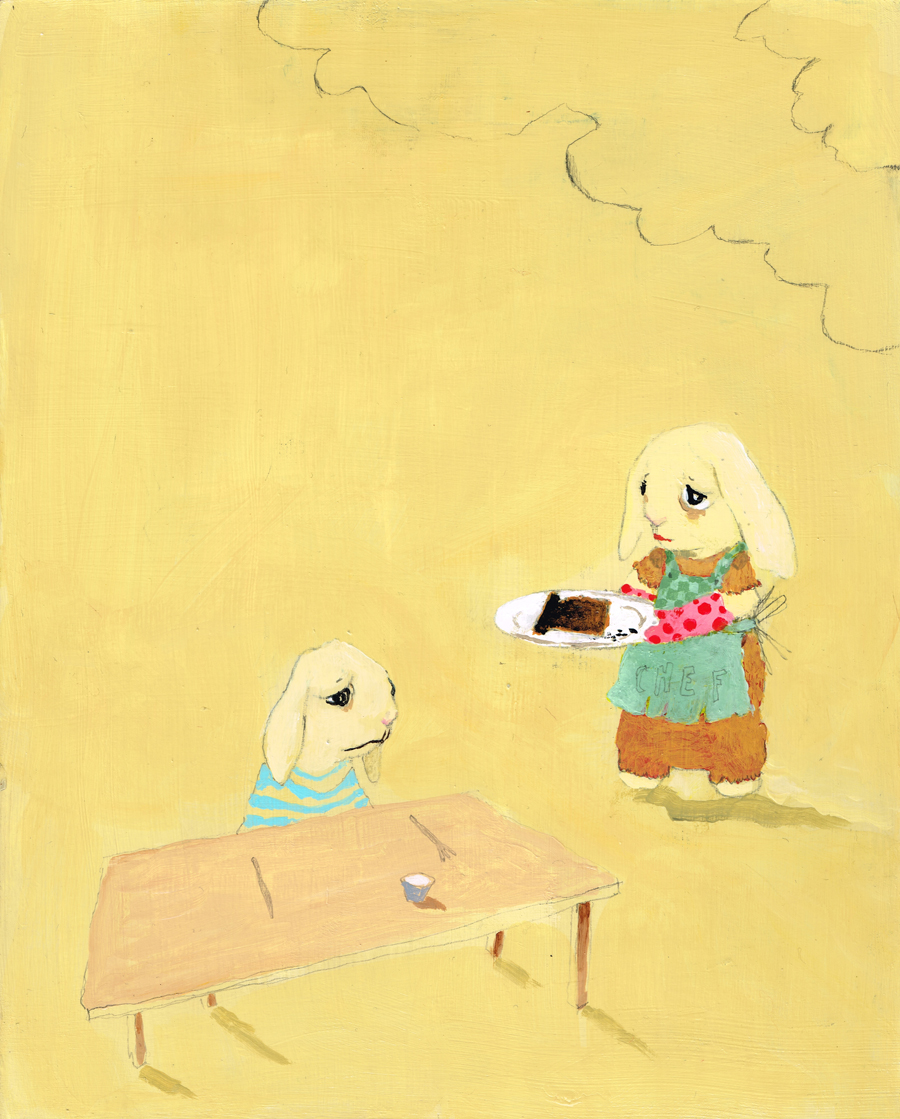
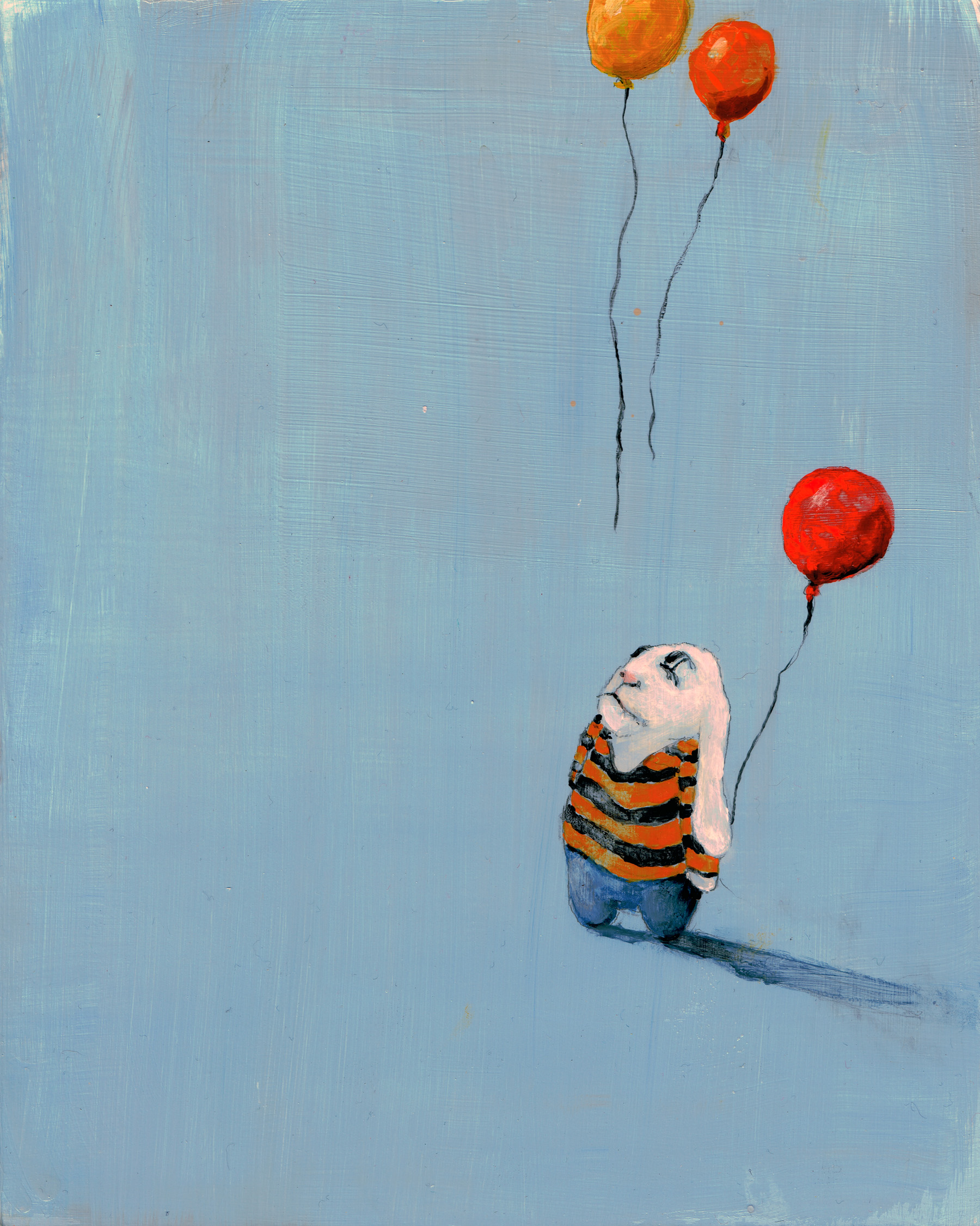
For more of Shari’s work, head to her website Art in Mind.
Feb 20, 2013 | music
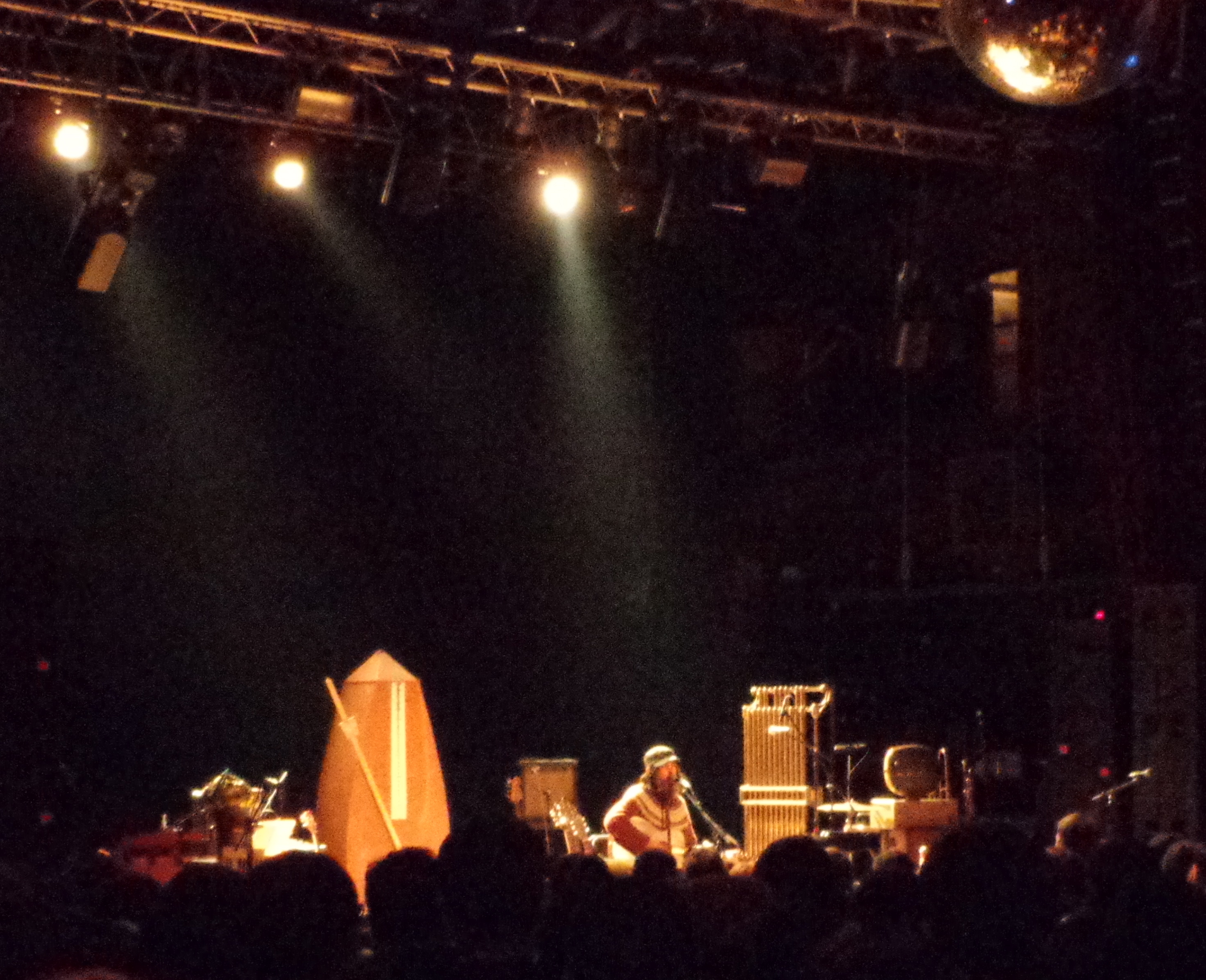
On Monday night in Providence there was a man with a guitar surrounded by hipsters on all sides. Lupo’s Heartbreak Hotel was full of them, but what else could you expect from a solo performance by the man behind Neutral Milk Hotel? Jeff Mangum fit the part too – unkept beard, lumberjack style clothes, and an I-only-care-about-the-music-who-let-you-people-in-here attitude. He was a hipster god, but he sang so well it made me wonder why his audience wasn’t a little more diverse.
His opening band answered that question though – started by another member of Neutral Milk Hotel, The Music Tapes exist somewhere between performance art and actual music, safe to say it wasn’t too close to either. All of their artsy vibes were lost on everyone more than ten feet back – we couldn’t see what was on their little TV (why does a band need a TV in the first place?) and we couldn’t understand anything Julian was saying in his excessive ramblings between songs, although I feel like I should write “songs” instead because it was more just noise than anything with a melody or rhythm. They also brought a giant metronome on stage that was only used for their first bit and just sort of loomed there the rest of the time, like an obviously symbolic backdrop. It was hard not to laugh out loud, but hipsters are great at staring daggers and making you feel like you must just not “get it.”
Jeff was fantastic though, singing “Two Headed Boy,” “King of Carrot Flowers Parts 1 and 2”, “Ghost,” and “Aeroplane Over the Sea.” It wasn’t till after the encore came that people emerged on the stage with him though, and the most featured instrument was a saw. The move made the whole performance seem kind of lazy, like he was banking on an encore to finish the set, a feeling compounded by the fact that he couldn’t have been on stage for more than an hour. Plus, Lupo’s is a concert hall, no seats and intended for dancing, which is not what you want to do while watching one man earnestly play his guitar, even if it is a fast-paced song.
Don’t believe me about The Music Tapes? Listen to them on Soundcloud and let me know if you think I’m wrong.
Feb 19, 2013 | books
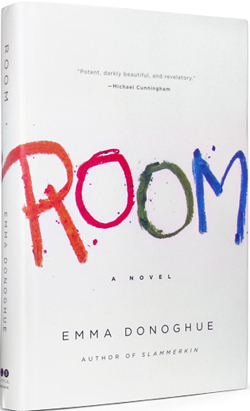
Poor brave little Jack. Room is his story, and he tells it as best he can, often revealing how smart a five-year-old can be – even one who has been locked inside an eleven-by-eleven foot space since birth. He shares his world little by little, allowing you to slowly piece together this adorable little boy’s situation: captivity, held with his mother who was kidnapped long before he was born, Jack himself the product of rape and years of incarceration in a tiny inescapable cell created by a demonic captor known only as “Old Nick.”
At first it feels as if much of the story will be lost on a five-year-old’s perspective, but it becomes very clear very fast that Jack is special, incredibly grateful and mature, and his story ends up being the most important, especially since you’re able to discover the world with him as he learns that all of existence is more than just Ma and Jack and Room.
“Ma’s put a smile on.
She’s tidying Pen back on Shelf.
I ask her, ‘How old are you going to be on your birthday?’
‘Twenty-seven.’
‘Wow.’
I don’t think that cheered her up.”
I don’t want to get into any more of the plot for fear of revealing too much, but this book is absolutely fantastic. Reading Jack’s developing English and explanations for everything allows for a complete immersion in his character. The book made my heart pound with worry and I teared up at least twice, so prepare to have your heart rocked.
Room’s website has an interactive element that was cool at first and then creepy, but it’s worthwhile to check out.
Book excerpt from page 16.
Feb 18, 2013 | painting
These characters come from the 1699 French novel Les Aventures de Télémaque that fills a gap in Homer’s Odyssey, telling of Ulysses son Telemachus’ educational travels with a mentor that turns out to be the goddess of wisdom Minerva. The author Fénelon tells of how Telemachus fell in love with this beautiful nymph Eucharis but his duty as a son demanded that he leave her and find his missing father.
In this scene they say goodbye, an image that David makes so powerful and real with a warm white light that sets their light skin aglow. Telemachus stares straight out at us, his face still babyish and framed by blonde curls, like a lamb who doesn’t know to be scared as it’s naively lead toward slaughter. That’s not what happens in this story though. Telemachus is rewarded for sacrificing in the name of his father, and at the end of the story he learns his mentor has been the goddess of wisdom this whole time and he reaches Ithaca safely and smarter and stronger than ever.
Eucharis wraps her arms gently around his neck, leaning her head on his shoulder, eyes downcast because she knows she’s about to be left behind and there’s nothing she can do about it. Telemachus has his right hand placed gently on her leg as a temporary consolation prize, holding his spear in the other hand, fingers spread across it as he leans back and acknowledges the viewer with his sad blue-eyed stare. A skinny ghost of a dog peeks his head out of the darkness in the right-hand corner, staring up at his master as another faithful admirer, but perhaps one that actually gets to come along.
This painting currently belongs to the Getty Museum in LA whose website reads, “David painted The Farewell of Telemachus and Eucharis during his exile in Brussels. The use of saturated reds and blues contrasted with flesh-tones and combined with a clarity of line and form typifies the Neoclassical style, which is characteristic of David’s late history paintings.”
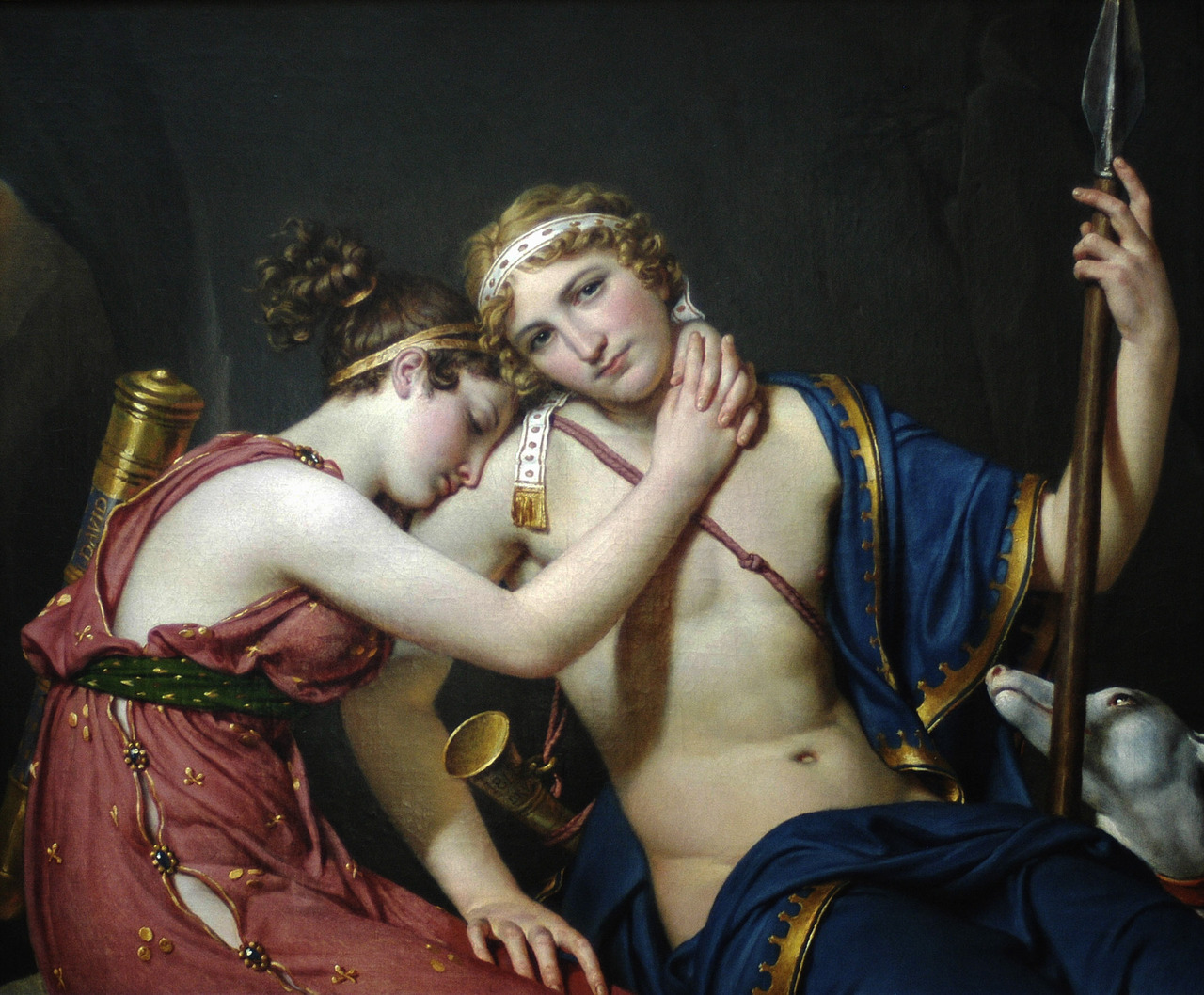
“The Farewell of Telemachus and Eucharis” by Jacques-Louis David
French, 1818
Oil on canvas
34 1/2 x 40 1/2 in.
For corrections and additions to my telling of this French novel, please email me. I did a good amount of research but unfortunately I can’t speak French and may have got a few things wrong.
Feb 15, 2013 | sculpture
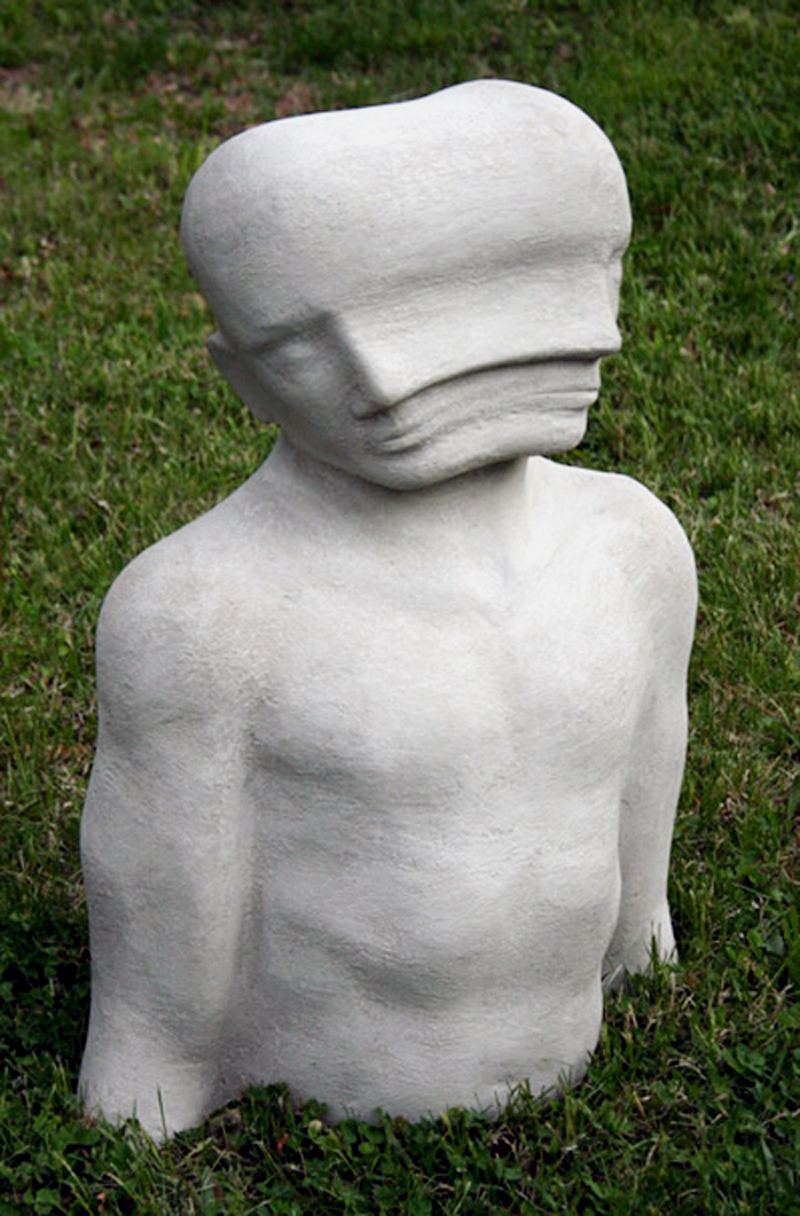
“Shift” by Emil Alzamora, 2008
A torso emerges from the grass, made of rough white rock with his swaying left to right – a motion indicated by a dizzying technique in sculpture magic that records all the little individual moments while the head moves through space and creates a fluid connection between two heads that looks like a sleeker artistic version of The Matrix. The tumblr Like a Field Mouse titled the piece, “Not shaking the grass” which I thought was cute. But the sculpture is actually called “Shift,” created by Peruvian artist Emil Alzamora, whose portfolio contains surreal sculptures of the human form like this one that twist and elongate bodies in ways that question nearly everything, from consumer culture to the time space continuum.
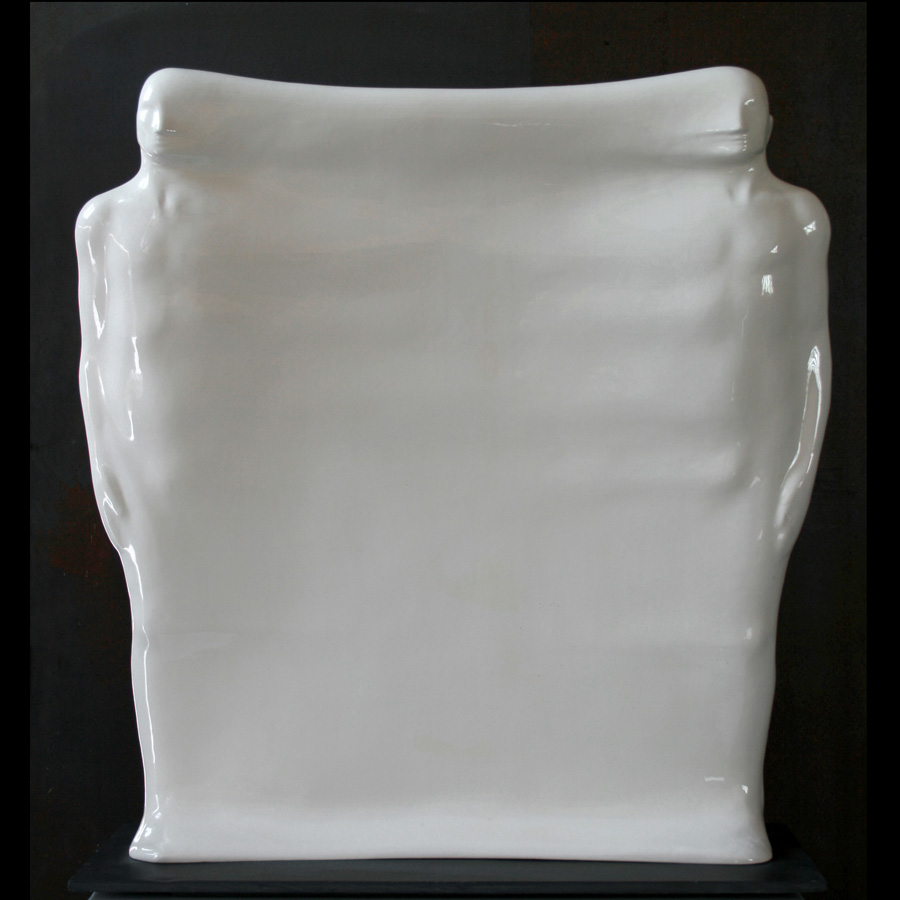
“Ultima Thule” by Emil Alzamora, ceramic, 2007
My favorite were these stuck-in-time sculptures, which included “Ultima Thule” too – a man standing in two places, connected to his former self by the same kind of blur of motion that’s repeated here but creates a more basic, symmetrical representation of the same idea. The sculptures in this world experience every moment individually and forever, multiple consciousnesses frozen between two places – eternal but limited.
The slenderness of their bodies almost makes them seem like aliens, like a Modern sculptural version of the Mannerist style that painters raved about after the High Renaissance, where women had long fingers and necks that reached just a little too high. The baby Jesus in Parmigianino’s “Madonna with Long Neck” looks like he was stretched like taffy, his long body way too giant for a baby.
But in Alzamora’s sculptures, this elongation is refined and tailored, the ceramic pieces often shiny with glaze. Some bodies remain muscular but most are thin with a remoteness that brings an element of robot to the alien/human mix. Be careful to keep these aesthetics away from the robotics industry cause it would be a poetic, beautiful death if they took over the world.
See more of Alzamora’s work on his website here.


 I fluctuate between giving color & detail to the areas surrounding my characters and leaving them alone in their space. An intense drive to express an idea, message or observation leaves me feeling that the figures can communicate strongly without anything around them. The blank or negative space is carefully considered and tells much about the tensions while simultaneously allowing for areas of visual repose.
I fluctuate between giving color & detail to the areas surrounding my characters and leaving them alone in their space. An intense drive to express an idea, message or observation leaves me feeling that the figures can communicate strongly without anything around them. The blank or negative space is carefully considered and tells much about the tensions while simultaneously allowing for areas of visual repose.












